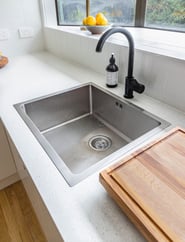Garbage Disposals: What to Put Down (and Not Put Down!) This Useful Kitchen Appliance
Garbage disposals have been the workhorse of American kitchens for more than 80 years, but they remain a mystery to many homeowners.
It is estimated that 50 percent of U.S. homes have garbage disposals installed in the kitchen under their sinks.
These electrically powered appliances, located between the sink drain and trap, can chop or shred food and other waste into small enough pieces to then pass through your plumbing system.
Garbage disposals are not only useful but can contribute to sustainability.
“(Garbage Disposals) do double duty, meeting the often competing demands of convenience and conservation,” says Consumer Reports. “Disposals grind spoiled meats, corn cobs, fish bones, ice, and all those veggies’ kids reject, discharging them down the drain to a wastewater plant (unless you have a septic system). When food waste is processed at a wastewater plant, it’s even more eco-friendly than composting. Plus, garbage disposals immediately rid your home of waste, odors, and any critters they might attract.”
Disposable History: InSinkErator and the Disposall
Garbage disposal history can be just as murky as your sink water gets prior to flipping the disposal switch.
Some claim that the garbage disposal was the brainchild of Racine, Wisconsin architect John W. Hammes, whose 1927 idea came in his basement one night while he was contemplating what to do with the dinner scraps from that night.
Eight years of tinkering later and Hammes received a patent for the InSinkErator, which started selling to the public in 1938, and can still be bought today.
“There’s a good reason that the name InSinkErator has been synonymous with garbage disposals for 80 years. They were our idea,” says the company.
Or could General Electric be the inventor of the garbage disposal? GE seems to have invented everything … and the kitchen sink and what’s under it as they unveiled the Disposall in 1935.
While the technology has certainly changed, the role of the garbage disposal has not changed much from ads for “kitchen grinder” that ran in the Popular Mechanics Magazine October 1935 edition: “Installed beneath the kitchen sink, an electric grinder quickly reduces garbage into a fine pulp which can be passed through the drain pipe into the sewer system.”
Garbage Disposal Do’s and Don’ts

Even long-time owners of garbage disposals may be confused by what you can put down – and should not put down! – your appliance.
One thing to keep in mind is that while your garbage disposal can lighten the load of your trash bin, it is not a complete replacement.
For starters, most people know that you can never put glass, metal, or plastic into your garbage disposal.
And forget putting paint, especially Latex or other oil-based paint, straight down the disposal after your home project – it can cling to your disposal sides and harden into a clog hazard.
Also, save cleaning chemicals for that laundry room sink as they can put excessive wear on your disposal and drain line.
There are other items, however, that are sure to start an argument about their placement in the garbage disposal.
“For the most part, garbage disposals can grind pretty much anything you throw at ‘em. Your plumbing, however, is another story,” says Consumer Reports.
Here is a list of items you should not place down your garbage disposal, according to Consumer Reports and other sources:
- Animal bones
- Banana peels
- Coffee grounds – large amounts
- Corn husks
- Egg shells
- Fibrous vegetables such asparagus and artichokes
- Grease, oil, and fat (items that congeal)
- Non-food materials
- Nuts and shells
- Onion layers
- Pasta, Rice, and bread (items that absorb water and expand)
- Potato peels
- Shellfish
According to Consumer Reports and other sources, the following food are safe to put down your garbage disposal:
- Coffee grounds – small amounts
- Cooked meat
- Corn cobs
- Fruit scraps including citrus rinds
- Ice
- Leftovers
- Vegetable scraps
- Small bones such as fish bones
“Basically, all other foods – from peach pits to corn cobs to cooked steak – can be ground up and washed down the drain,” concludes Consumer Reports.
Peach pits, we should note, are still a controversy as they will make some “do not throw into your disposal” lists and others say it is fine to grind them up.
As always, the best course of action is to consult your garbage disposal owner’s manual before flipping the switch!
If you have questions about your current garbage disposal, or it is time for an upgrade, contact family-owned and operated Pilot Plumbing in North Houston and Montgomery County to have all your questions answered.
